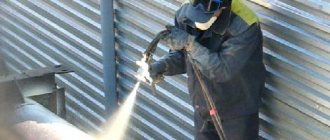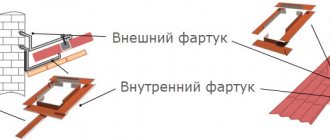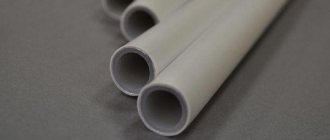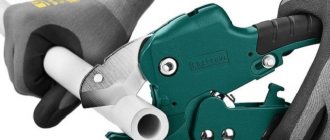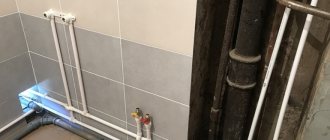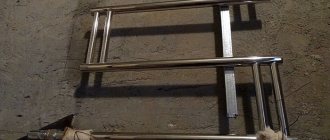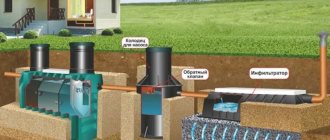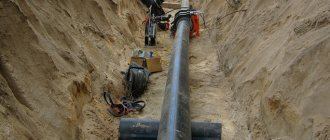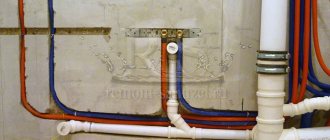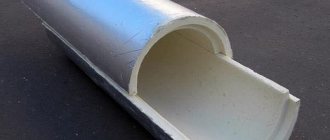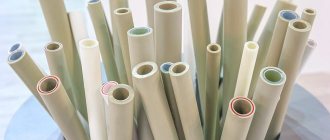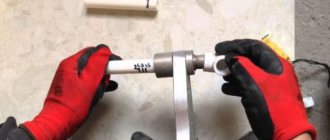For all types of work with PP pipes - installation of heating or plumbing systems - you will need a tool for polypropylene pipes. Since pipes are sold in coils or in long straight sections (up to 12 m), special pipe cutters are required for cutting. When assembling the pipeline, welding machines and glue guns are used.
Set for polypropylene pipes
Scope of application of various tools
Polypropylene pipe products are widely used in many areas, but they are most in demand and important when installing water supply lines. The popularity of polypropylene pipes is primarily due to the fact that they are lightweight and easy to use, have excellent technological characteristics, durability and low cost. At the same time, professional installation of water pipes often costs much more than the cost of materials.
You can avoid such costs if you take on this work yourself. This is not a difficult task: with minimal skills and having read the assembly instructions, almost anyone can do it. All you need for this: a little desire and effort, the availability of the necessary materials and, of course, tools for installing polypropylene pipes.
When working with polypropylene pipes, you need to perform different actions, so the tools you have to work with are also different.
Types of polypropylene pipes
Many craftsmen who are planning to perform one or another type of plumbing work sometimes face the pressing question of choosing the right choice of polypropylene pipes.
The modern plumbing market today offers a very wide range of different types of polypropylene pipes, which are usually classified depending on different parameters and properties.
To help the reader understand this issue, below are the main classifications of polypropylene pipes.
- Classification by purpose The main feature of polypropylene pipes is their reaction to high temperatures! Depending on this, polypropylene pipes are usually divided according to the type of substance that will be transported through them, namely:
- hot water;
- cold water;
- heating;
- sewerage;
- ventilation.
- According to the material of manufacture Polypropylene pipes are usually divided into the following types with the corresponding designation:
- PPN – made of homopropylene and is the optimal solution for the installation of industrial and domestic cold water pipelines;
- PPB - the manufacturing material is a block copolymer of propylene, which gives the pipes the property of increased resistance to hydraulic shocks;
- PPR is made from random propylene copolymer with the addition of ethylene, ideal for supplying hot water whose temperature does not exceed 70 C;
- PPS, the unique chemical composition of special polypropylene, gives the pipes the property of increased heat resistance (withstands temperatures of 90–95 C), which, in turn, makes it possible for them to be widely used in various fields.
- By type of design The following types of polypropylene pipes are distinguished:
- single-layer (their types were indicated above);
- multilayer pipes, in turn, are divided into the following variations:
- reinforced structure, which has a layer of aluminum foil located inside the wall;
- a structure in which the inner layer is reinforced with fiberglass;
- The polypropylene-reinforced structure implies the presence of an inner layer of polyethylene.
- According to the ability to withstand rated operating pressure polypropylene pipes are divided into the following types with appropriate markings:
- with a working pressure of 1 MPa are marked as PN10;
- pressure 1.6 MPa - marking PN16 (rarely used type of pipe);
- permissible pressure up to 2 MPa – PN20;
- pressure up to 2.5 MPa – PN25 (rightfully considered the most durable and heat-resistant type of pipe).
- By outer diameter and wall thickness The following types of polypropylene pipes are distinguished:
- PN10 – outer diameter 20–110 mm, wall thickness – 1.9–10 mm;
- PN16 – diameter 16–110 mm, wall thickness – 2.3–15.1 mm;
- PN20 – diameter 16–110 mm, wall thickness – 16–18.3 mm;
- PN25 – outer diameter 21.2–77.9 mm, wall thickness – 4–13.2 mm.
- By color of polypropylene pipes You can immediately find out the features of its use:
- white color – the pipes are distinguished by excellent anti-corrosion properties and long service life;
- gray color – have excellent thermal and chemical resistance;
- black color – resistance to aggressive substances;
- green color – minimum indicators of resistance to internal pressure.
structure reinforced with corrugated aluminum on the outside;
However, many experts believe that the color of polypropylene pipes does not affect their quality at all.
Pipe cutting
The process of cutting polypropylene pipes can be carried out in two ways. First: preliminary measuring all the necessary sections and cutting in accordance with these measurements. The second method: cutting at the junction directly during installation.
As a rule, the second method is more practical and convenient and gives better results. The cutting of pipe products itself is carried out using special scissors (for more details: “Which scissors for polypropylene pipes is better to choose - types and advantages”). With this pipe tool, polypropylene can be cut perfectly straight, which is necessary for high-quality installation.
Of course, it’s good if you have such scissors at home or on the farm. However, if they are not there, it is hardly worth purchasing this tool for one-time use. Instead, you can use a turbine or a hacksaw, and carefully process the burrs and irregularities with a file. However, the pipe must be firmly secured before cutting with these tools. Read also: “Which scissors to choose for cutting polypropylene pipes - types and features of the tool.”
Joining of polypropylene and polyethylene materials
The connection of polyethylene and polypropylene parts of the pipeline may be required when installing cold water supply. They also use specially made fittings for threaded and flanged connections and soldering.
- The first connection method, when the fitting involves welding with a polypropylene part and a crimp connection with a polyethylene pipe.
- The second method is a flange connection. The flange joint is sealed by installing a rubber gasket.
The need for such a combination arises if the supply to the house is made of polyethylene materials, and the internal wiring is made of polypropylene.
Chamfering
Often, before connecting pipes with fittings, it is necessary to chamfer them at the ends from the outside. This is done so that the pipes, after melting at the ends, are inserted into the fitting easily, without clinging to the edges. Otherwise, the material of the heated pipe can become deformed very easily.
A regular steel knife can be used as a tool for chamfering polypropylene pipes. All that is required in this case is to properly sharpen the pipe bevel cutter before work. Another option is to use an emery disc or turbine disc to remove chamfers from polypropylene pipes by grinding their edges.
Connection to valves, filters and mixers
Owners of polypropylene water pipes cannot escape threaded connections either. At a minimum, when installing faucets, you will need an adjustable, gas, or several open-end wrenches.
We always go back to basics
Union nuts ensure tightness with special rubber gaskets; For a faucet in a bathroom when mounted on a wall, you will need to rewind the connection. It is best to use regular linen with the addition of any quick-drying paint or drying oil.
The same applies to the connection of the first water supply fitting to the valve or filter.
Tip: when tightening the thread after the valve, it is advisable to hold the valve or filter itself with a second wrench, preventing it from turning.
Otherwise, you will have to turn it back later; After this, the thread underneath may leak.
Here, in principle, is the entire list of tools. As you can see, it does not contain anything exotic or prohibitively expensive; Most of the tools can be found in every home where the owner’s hands grow from an adequate place.
Good luck with the renovation!
Did you like the article? Subscribe to our Yandex.Zen channel
Cleaning the outer surface and ends
Stripping is required for polypropylene pipes with aluminum reinforcing film, which can be located between polypropylene layers in the walls of the product or outside. Depending on this, you may need a tool for external stripping of such pipes or a trimmer (for more details: “Is stripping necessary for polypropylene pipes and how to do it if necessary”).
It is not possible to replace these devices with home equipment, but any of these tools for polypropylene pipes are easy to find on sale. Their price is very cheap, since the composition does not contain complex mechanics or a significant amount of expensive types of steel.
What do you need to have for work?
It’s worth noting right away that if repair and installation work regarding water supply and heating systems will be carried out regularly, it is recommended to purchase high-quality and reliable equipment, as well as a full set of tools. Even the highest quality units require systematic timely care and equally careful storage.
Tools you can’t do without include:
- directly polypropylene pipes;
- pencil;
- electric extender;
- measuring tape;
- hammer drill (useful for chiseling concrete surfaces);
- drill;
- grinder;
- construction level;
- scissors with which you can cut polypropylene pipes;
- welding machine (“soldering iron” or “iron”).
Pipe installation
The main tool for installing polypropylene pipes is a special soldering iron. It consists of a heating element and replaceable nozzles, through which the pipe and fitting are simultaneously heated.
In fact, a soldering iron for polypropylene pipes works on the principle of an iron. When heated, it heats up and melts the polypropylene products placed on it, allowing them to then be connected to each other by soldering. If you need to work with pipes of different diameters, then a kit with a large number of nozzles should be available.
The process of installing polypropylene pipes using a soldering iron is carried out as follows:
- An appropriate nozzle for the pipeline being installed is selected, which is installed on the soldering iron, after which the device is heated to 260 °C.
- The pipe is inserted onto the nozzle from the wide side, and the fitting from the narrow side (since the pipe is inserted from the outer diameter, and the fitting from the inner diameter).
- After melting of the surfaces to be joined, the products are removed from the nozzles. The pipe is inserted into the fitting, and the products are fused with each other.
- Wait about half a minute for the joint to completely harden and fix. During this time, the products should not be subjected to movement relative to each other.
Upon completion of these stages, the welding (soldering) process can be considered complete.
Tools for working with plastic pipes REED
REED has developed a unique tool for installing plastic pipes and has done everything possible to ensure that repair work is carried out without the slightest error and as quickly as possible.
A pipe cutter for REED plastic pipes,
this proprietary development of the company, is an industry standard and is actively imitated by other tool manufacturers. Simplicity of design and reliability ensure easy and precise cutting of plastic pipes without burrs, with a diameter from 3 to 254 mm. A ball lock on the roller axis makes it easy to change the cutting roller, which speeds up the work process. The pipe cutter slides are made of magnesium for added strength. Thanks to the rotational movements during cutting, the chamfer is removed, which allows you to immediately begin connecting with other shaped parts.
REED Pipe Cutting Shears
Designed for fast cutting of small diameter PE, PEX, and thin-walled PVC, rubber or nylon pipes. All models feature a ribbed handle for added safety, and the nylon construction is reinforced with fiberglass. The special design of the blade allows them to remain sharp and perform precise cuts over a long service life. For best cutting, the scissors should be rotated around the pipe while squeezing the handles. The line includes scissors equipped with a seven-step ratcheting mechanism and an extended base, designed for one-handed operation in places with minimal clearance between the pipe and, for example, a wall or floor. All scissor blades are easily removable and can be sharpened or replaced. There are replaceable Teflon coated blades with a lubricant that allows the blade to cut easily and smoothly, as well as more durable stainless steel ones.
Rotary pipe cutters
for plastic pipes REED is suitable for cutting pipes with a diameter from 106 to 800 mm from PE and PVC in trenches (excavations) or above ground. Pipe cutters such as PLAS require a clearance around pipes of only 153-203mm. The pobedit-tipped cutters of this tool for PVC pipes are designed for long service life and cut pipes with a wall thickness of up to 50 mm. Due to the specific shape of the cutter, simultaneously with cutting, a 15° chamfer is formed on both sides of the cut. The curved blade allows the chips to be cleared away from the working area, thus making it easier to cut PE pipes.
Pipe cutters for guillotine plastic pipes REED
Designed for cutting medium and high density PE pipes with a diameter of 63 to 350 mm. The special blade design with a slight bevel angle makes it easy to start cutting. Thanks to the Teflon coating, an even and straight cut is ensured without burrs and chips, which allows you to save on further processing of the end. For operation, a minimum clearance around the pipe is required of only 102 - 152 mm. Blades are sharpened and replaced.
REED chamfers for plastic pipes
PVC, CPVC, PE, ABS and PP provide high-quality grinding and chamfering in a minimum amount of time. In each tool you will find at least three sizes for each type of pipe, both internal and external diameter. For large volumes of work, there is a device for chamfering driven by a drill (drill not included) that eliminates fatigue. The REED BT chamfer model is attached to the end of the pipe and in a circular motion we remove the chamfer on pipes with a diameter of 40 mm to 300 mm.
Countersinks for plastic pipe fittings REED
clean pipe debris and remaining cement layer from PVC, CPVC and ABS fittings. Thanks to the ability to reuse fittings, labor time and material costs are reduced. Countersinks for plastic pipe fittings fit into an electric or cordless drill with a 10mm chuck. They are successfully used to work with ventilation, drainage and water pipes. The countersink carbide cutting insert provides a cutting edge on either side. Available in seven sizes from 3/4″ (19mm) to 4″ (101.6mm), both individually and as a set.
REED Plastic Pipe Stripping Tool
prepares the outer surface of the plastic pipe for welding, removing the oxidized layer and contaminants. The spring-loaded blade applies even pressure to the pipe to ensure a smooth finish. The plastic pipe scraper can be used on the end of a plastic pipe or anywhere on the pipe, with only 6″ (150mm) of clearance to rotate around the pipe.
REED polyethylene pipe flaring tool
Creates a cold flare after 10 light full turns for connecting plumbing systems. These tools are suitable for flaring medium to high density PE pipes with diameters of 3/4″ (19mm) and 1″ (25.4mm).
REED crimping pliers
for PEX pipes are designed to clamp copper rings used on brass fittings of PEX (molecular cross-linked polyethylene) systems. The design of such crimping pliers eliminates the possibility of deformation and destruction of rings. Each tool comes with a special fit tester and a hex key.
REED saw for plastic pipes
– the composition of plastic pipes, in particular PVC pipes, contains very hard materials, and therefore saws intended for cutting wood will become dull very quickly. Therefore, there was a need to create saws with appropriate parameters, proper completeness and rigidity, ensuring effective cutting of plastic pipes. The teeth are sharpened on both sides and have a hardness that exceeds the hardness of the file teeth. Models PPS12 and PPS18 have a molded handle design and a replaceable low-profile blade, which makes it possible to work in cramped conditions with pipes up to 100 mm in diameter. The handles on the PPS20 and PPS24 models are permanent, and the wider blades have 11 teeth per inch (more than the conventional design) and a unique shape that eliminates vibration of the plastic or wood when the saw blade reciprocates. They cut pipes up to 200 mm.
The REED
Pipe Cutter (Internal)
is designed to cut plastic pipes from the inside where other tools cannot reach, below the floor or above the ceiling. All cutter guides are made of heat treated steel and fit a standard 9.5mm drill chuck. During operation, special chamfers on the guides with a large cutter keep the cutter from slipping in the clamping jaws of the drill, and a lock washer on smaller cutters keeps the blade from slipping. The presence of a depth gauge allows you to make a cut at a given distance.
REED Plastic Fan Pipe Connection Device
allows one person to connect PVC or PE pipes up to 16" (406.4mm) in diameter, connected using a sealant, or up to 12" (304.8mm), connected using cement mortar.
REED Polyethylene Pipe Closing Tool
designed to shut off the flow of process fluid in polyethylene pipes with a diameter from 1/2″(12.7mm) to 8″(219mm). Various models of this tool are used in a wide range of pipe sizes and applications, with manual and hydraulic drive. Oilers located at friction points provide smooth operation and increase the service life of the tool. Aluminum supports are anodized or painted to protect the elements from corrosion. All tools for compressing polyethylene pipes have fixed stops to prevent damage to the pipe due to excessive compression. Adjustment for different pipe sizes, on one pair of stops, ensures timely and convenient prevention of excessive compression of standard diameter pipes.
Reed strongly recommends the use of a Grounding Device
as a precaution against the accumulation of static electricity. Eliminate static electricity and minimize the possibility of fire.
REED ESD Alarm
warns of the build-up of static electricity, which can lead to possible breakdown of the plastic pipe due to electrical discharge through the pipe wall during compression or cutting.
Connection to valves, mixers and filters
In most cases, connections of polypropylene pipes with the mentioned products and devices are made using a threaded method. If union nuts are used for installation, then sealing in them is achieved due to the presence of rubber gaskets inside; otherwise, the threaded connection requires additional winding from impregnated flax strands, plumbing thread, fum tape, tow, etc.
The very implementation of threaded connections will require an adjustable wrench or a wrench, or a set of open-end wrenches of various sizes.
The listed set of tools is sufficient for installing polypropylene pipes at home, and if you have them on hand, you can easily begin assembling a home water supply system on your own.
Installation of polypropylene water supply
Types of water supply connections:
- sequential;
- collector
Serial wiring using tees
Tee pipe routing
From the main risers of hot and cold water supply, branches are made using tees to all points of use. A significant disadvantage of such a system is the dependence of each subsequent consumer on the previous one, that is, the pressure at the end point, when consumers are turned on at the same time, will be significantly lower. Advantage: saving of materials during installation.
Detailed description of the welding process
To master the process of installing polypropylene pipes, you need to study welding technology. Tools required for work: marker; measuring tool; precision shears, auto shears or pipe cutter; for reinforced products shaver; welding tool.
How to properly prepare a polypropylene pipe?
Using a tape measure, measure the required length of pipe. Use a marker or pencil to make a mark on the product. An incision is made along the mark left. During the cutting process, the pipe should be positioned at right angles to the shear blades. If you need to cut a short piece of pipe, position it so that the longer section of pipe is to the right of the tool. This way you will avoid its deformation.
Article on the topic: Scissors for cutting polypropylene pipes: which ones to choose and how to use them correctly
If polypropylene pipes with reinforcement are used, then before starting welding work you need to clean the aluminum layer at the junction of the parts. Otherwise, when it comes into contact with water, it will be subject to corrosion, which over time will lead to defects in the connection, which in turn will cause a leak.
Cleaning is done with a shaver. Its depth is half a centimeter greater than the socket of the fitting used. An important condition for high-quality welding of pipes is their degreasing at the joints. Alcohol wipes work well for this process. Gasoline and solvents should not be used to degrease polypropylene pipes.
To ensure an even cut of the pipe, it must be positioned at right angles to the blades of the cutting tool. For a strong connection, the pipe section must be degreased before welding.
If the aluminum layer of the reinforced pipe is not cleaned before installing the pipeline, over time the connection will corrode and its integrity will be compromised.
The fitting is also degreased before welding. The welding depth is marked on the pipe. This will help control the depth of insertion of the pipe into the fitting.
You need to make a mark on the pipe by trying on the fitting to it. This way you will clearly know the welding depth.
Tips for preparing your welding tool
The welding device must be placed on a flat, stable surface. The process uses two attachments: a sleeve and a mandrel. The first is used for the pipe, the second for the fitting. They are selected taking into account the size of the pipes. Before putting on the parts, it is advisable to degrease them too.
Attention! Attach attachments to the welding machine only when the device is turned off.
The nozzles are made of Teflon, which, when heated, does not cause polypropylene to stick to the surface. After putting on the attachments, turn on the device. When the indicator on the device body goes out, you can start welding.
Polypropylene pipe welding technology
If the work is being carried out for the first time, it is advisable to practice on a small section of pipe. Since you will have to deal with high temperatures, it is better to use construction gloves. They will help protect your hands from burns.
Advice. After the device reaches the desired temperature, you need to wait 5 minutes before starting the process. And only then start welding.
Holding the pipe in one hand and the fitting in the other, I simultaneously put them on the heated nozzles. In this case, you need to apply a little force, but be careful not to melt the pipe beyond the mark. The time during which the required heating of the parts occurs is calculated according to the table. Counting begins after the parts are completely seated on the device.
As soon as the time is up, the parts are removed from the device and the pipe is inserted into the fitting up to the mark. After this, you need to wait a few seconds, and then do not make any impact on the alloy until it cools completely. During the process of heating and joining parts, it is not recommended to displace them along the axis.
When pushing the fitting and pipe onto the nozzles, you need to apply a little force. At the same time, you need to ensure that the parts do not warm up deeper than necessary.
When working with polypropylene pipes, the heating, connecting and cooling times of the elements should be observed. The quality and durability of the pipeline depends on this
You can check the connection by looking inside. The formation of “noises” is considered a defect, since they affect the throughput of the highway. They can result from failure to maintain the melting temperature or if the pipe is inserted into the fitting further than necessary. In any case, such a defect affects the efficiency and service life of the pipeline.
Attention. Work on the installation of polypropylene pipes cannot be carried out in rooms where the air temperature is below 0°.
If polypropylene pipes are walled up, then before installing them in the wall, you must first assemble the entire section of the pipeline. And only then fasten it into the groove.
